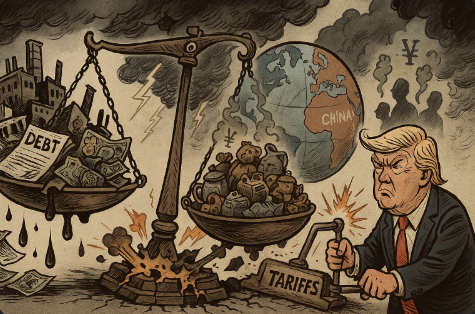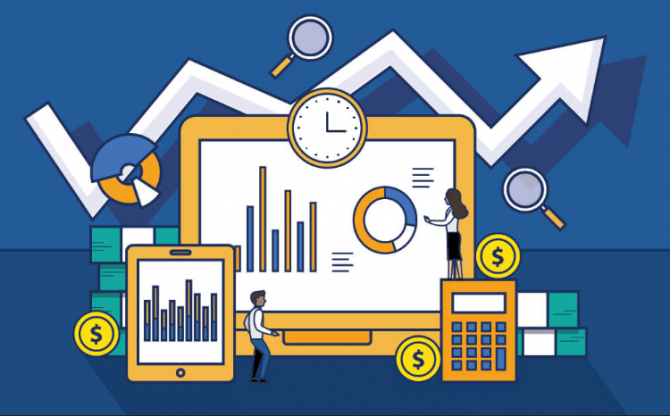
Trump’s trade war is dumb in almost every way.
The tariffs are crude, cruel, and unfair. The execution is clumsy, and the rationale behind it, at least as presented, is vapid. The economic fallout will likely be painful.
But whether he knows it or not, he’s grappling with a real problem. One that’s been building for years. One that was never going to end neatly.
Free trade advocates, of which I (Andrew) am one, need to admit that trade between China and the rest of the world, especially the U.S., was never really free to begin with. China was playing silly buggers long before the orange buffoon showed up.
If trade between the U.S. and China were truly open and unperturbed by manipulation, we’d have seen the yuan appreciate steadily and meaningfully over time.
Think about it: an American consumer buys a widget from China and pays for it in dollars. But the Chinese exporter needs yuan to pay their workers and suppliers, and to enjoy the fruits of their labour back home. So they trade those dollars for local currency.
In a free market, that creates upward pressure on the yuan: demand rises, so the value rises. That would gradually erode China’s pricing edge, making its exports pricier over time (but also giving Chinese consumers more buying power globally).
Under such a system, the pricing signal coordinates the allocation of capital and resources efficiently, and all trading partners are (in aggregate) better off as a result.
But China didn’t let that happen.
The mechanics are murky, but in short, the central authorities conjured yuan out of thin air and sold it to local exporters in exchange for their U.S. dollars. They dampened the inflationary side effects by issuing local bonds (to soak up the extra liquidity) and going big on infrastructure binge. But make no mistake, the yuan was deliberately debased.
The reason why Chinese workers didn’t notice was because despite this debasement, their standards of living still improved significantly. The Chinese peasantry went from dirt poor to less poor, and the politically connected got stinking rich, because the gains from international trade and the explosion of productive capacity were so vast they could offset much of the inflationary impulse.
To be clear, the CCP has very much exploited its own workforce; it’s just the crumbs that fell from the table were large enough that most Chinese workers still saw their standard of living improve.
This strategic manipulation allowed the CCP to build a vast war chest of USD. Money it could use to further its geopolitical influence and acquire significant holdings of US equities, property and (most importantly) US treasuries — assets it could use to generate even more USD.
And, as we know, money is power.
Why on Earth would the US allow this to happen? Why directly fund the rise of a geopolitical adversary, while at the same time hollowing out its own manufacturing base and building excessive levels of debt?
Well, because it too got rich in the process. Or, more accurately, it had the illusion of being richer by strip-mining its capital base to maximise profits and consumption. A process that happens so slowly as to be very difficult to see.
In the US the (perceived) benefits were not evenly shared either. So-called “coastal elites” saw profit margins and asset values soar as they too exploited (artificially maintained) cheap Chinese labour. But this came at the expense of much of its own labour force. Moreover, all the “capital recycling” of USD from China allowed them to spend well beyond what they could collect in taxes (as did the so-called petrodollar system and USD’s global reserve status, but that’s a story for another time).
Rust Belt workers got a consolation prize: cheaper Chinese goods (a deflationary perk), and a lighter tax burden (thanks to all those willing bond buyers). But the long-term rot was baked in.
Only now, after decades, are the consequences hitting home. As we talked about last week, profits aren’t wealth. They’re the downstream effects of capital formation and productive capacity. Or, in America’s case, the consumption of its capital base.
Consumption rose (unsustainably), while the real bedrock of real wealth crumbled.
Not that China got off scot-free. Sure, they gained enormous power. But they also piled on insane mal-investment, mountains of debt, and massive monetary debasement. The unwind has begun. It may be slow, but it is underway.
From either perspective, it’s an unsustainable dynamic. Especially when the U.S. and China are operating under fundamentally different political systems, with mutually incompatible worldviews.
If the U.S. does nothing, the logical endpoint is bankruptcy; fiscally and industrially. China would gain more sway over global finance, own ever more U.S. assets, and set the cost of capital for the West.
For China, there’s a price too. If your biggest customer is financially stretched, and not too fond of you, you’re in trouble. They’ll need to pivot to find new buyers or spark local consumption. But all that over-investment and debt likely means a financial reckoning, and when that happens political upheaval is never far behind.
Still, they probably come out ahead. At least from the CCP’s perspective.
The really scary thing is that all of this significantly ups the odds of a conflict between global superpowers.
Trump didn’t create this mess. But he’s helped accelerate the endgame. Even if he backs off, the die is cast.
The truth is that the world is in for some pain. And this pain cannot be avoided, which is a crucial point many seem to overlook.
Why? Because the damage has already been done. It’s not a question of steering away from future wealth destruction, but at best avoiding further wealth destruction. And this requires immense, prolonged and costly investment.
Capital formation, at least to the extent that the US and its allies can remove the dependency on China, will take many, many years, and come at considerable cost. Especially so with less Chinese trade and the associated capital recycling that has suppressed the cost of capital for so long.
And, because investment must always precede production, and production must precede consumption and profit, it’s going to be very difficult to avoid contraction and inflation in the meantime. Even if things get better in the long-term, stagflation appears to be an unavoidable reality in the medium term.
To be clear, I’m not trying to justify Trump’s actions. They are ham-fisted, and lacking any diplomatic or strategic finesse. But the US does need to do something; and it can either engineer it with a honest and accurate admission of the situation at hand and take its medicine, or it can have its hand forced by economic reality.
Given the political incentives at play, my best guess is that the latter will prevail. Indeed, the US will probably make its situation worse by throwing unending amounts of “emergency support” at the problem.
Sadly, no amount of financial engineering can solve this particular problem, but history suggests that that is exactly what the powers that be will try.
More simply put: money printer go brrrr.
We’re entering a new era; more protectionism, higher inflation, slower growth. Stagflation is the game now. It’s not the end of the world, but it will sting. For some much more than others.
Overleveraged holders of unproductive and overvalued assets will be hardest hit (I’ll let you decide who best fits that description). The poor, with little to no real assets to speak of, are likewise in for a tough time. All they have to sell is their time and energy.
People and businesses with strong balance sheets and productive assets will be more or less fine. In fact, relatively, they will likely come out ahead.
So this isn’t a “run to the bunker” moment. Humanity has been through worse. And diligent investors will still find opportunities. But it does mean being thoughtful about where you park your wealth.
Just remember that a global reordering is something that will take a long, long time to play out. And all kinds of unintuitive things can happen in the meantime, with plenty of false starts along the way.
If the financial and monetary interventions are heavy-handed (and I suspect they will be), we might even get a sharemarket melt-up. Overpriced stocks could get even frothier as mountains of liquidity go looking for a safe harbour. After all, there are trillions tied up in toxic sovereign debt, and billions more about to be magicked into existence.
Understanding what value really is, knowing how to identify it, and having the fortitude to stay the course, are more important than ever.
The nice thing about such a focus is that even if this thesis is wrong — and it very well could be — a disciplined, value-oriented approach is always sensible.
Good luck!
Strawman is Australia’s premier online investment club.
Members share research & recommendations on ASX-listed stocks by managing Virtual Portfolios and building Company Reports. By ranking content according to performance and community endorsement, Strawman provides accountable and peer-reviewed investment insights.
Disclaimer– Strawman is not a broker and you cannot purchase shares through the platform. All trades on Strawman use play money and are intended only as a tool to gain experience and have fun. No content on Strawman should be considered an inducement to buy or sell real world financial securities, and you should seek professional advice before making any investment decisions.
© 2025 Strawman Pty Ltd. All rights reserved.







